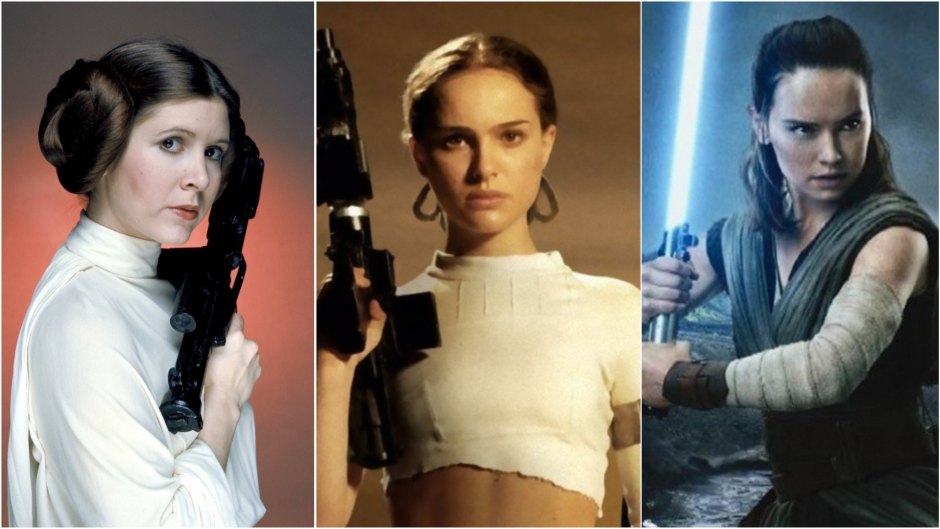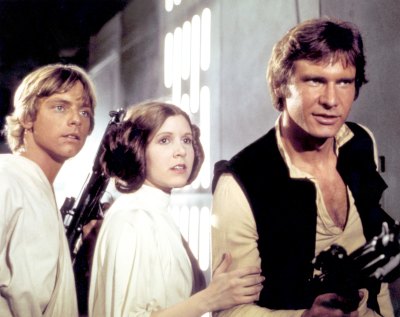
The Women Of ‘Star Wars’ Finally Come To Power — And It’s About Time! (EXCLUSIVE)
The women of Star Wars have finally risen to a point of equality to their male counterparts, as proven by the fact that so much of the action of recent films in the series have been dictated by female characters, from Daisy Ridley’s Rey in The Force Awakens and The Last Jedi, to Felicity Jones as Jyn Erso in Rogue One: A Star Wars Story. Not to mention the obvious leader of them all, the late Carrie Fisher as Leia Organa; as well as a variety of others who have appeared on the big screen, in animated series on the small, and in various novels and comic books.
These characters are the focus of author Amy Ratcliffe’s new book, Star Wars: Women of the Galaxy, which takes a comprehensive look at dozens of them, providing profiles of who they are (along with drawn portraits by numerous artists) and featuring comments from many of the actresses who have brought them to life.

(Photo by Sunset Boulevard/Corbis via Getty Images)
Part of the inspiration to do the book came from initial fan backlash that The Force Awakens received. Although it features the return to the series of Harrison Ford and Carrie Fisher, and the introduction of new characters like Oscar Isaac’s Poe Dameron, John Boyega’s Finn, and Adam Driver’s Kylo Ren, it had a female character, Rey, very much at the center of things.
“Rey was the first female lead in one of these films,” Amy explains. “Leia and Padme obviously had very key roles, but when you think of those films, you think Luke Skywalker and Anakin Skywalker. It’s been the Skywalker story, so it was a huge moment to learn, one, we were getting more Star Wars and, two, the lead was a female character. I remember even more fanboys getting upset when Rogue One was announced along with Jyn Erso. The attitude became, ‘They’re putting in too many women.’ Now I understand that counting is hard, but c’mon.

(Photo Credit: Lucasfilm)
“Something I’ve been vocal about in my fandom is seeing more of an equal representation on screen,” adds the author, who has a long history of not just being a Star Wars fan, but a professional writing about the franchise for, among other places, starwars.com. “I remember this mixed feeling of being upset and excited when the first cast photo from Episode VII was released. It included Daisy Ridley and Carrie Fisher, but then a lot of dudes. Ethnically diverse, which was great, but it’s, like, this can’t be enough. It’s 2014 at that point, 2015.”
The frustration carries over to the toy arena as well, where it’s been a struggle for licensees to put out action figures for female characters. “Even Rey was missing from a lot of Force Awakens sets,” she notes. “With all of that in mind, when I received an email from Chronicle Books about whether I was interested in doing a project about female characters in Star Wars, it was a no brainer.”

(Photo Credit: Lucasfilm)
Amanda Ward, who is co-host of the Rebel Grrrl podcast, agrees with Ratcliffe that there was outrage from fanboys about the new wave of female heroes. “Some Star Wars fans,” she points out, “still hold antiquated views that Star Wars is ‘for boys,’ or that women aren’t interested in it. The change to make the main protagonist a woman from the previous two trilogies was a change that likely fit well in Disney’s business model in a post Twilight and Hunger Games world, but rather than roll with it, fans saw it as an exclusion of men from the franchise. At the end of the day, the men shouting about forced inclusion from behind their computer screens did little to hinder the success of Rey’s trilogy and the many other films, books, and comics that have focused on women in Star Wars since then.”
Jason Ward, Amanda’s husband and the “force” behind makingstarwars.net (both the website and the podcast), observes that on the run up to The Force Awakens, “Some of the seedier aspects of society came out to protest Finn being a black stormtrooper and Rey being a young woman. There’s a perspective which insists diversity on screen is always forced. If Rey was a sex kitten like, say, early Lara Croft, there would be no issue, because it would be unmistakably about men. Rey and the current generation of female Star Wars heroes represent Star Wars being for everybody.”

(Photo Credit: Lucasfilm)
Putting aside bruised fanboy feelings, in tracking the evolution of Star Wars women, Amy notes, “It started with Leia and then we got Padme, and they’re both awesome. But I think it really started becoming more equal in the gender area when The Clone Wars came out and we got Ahsoka Tano, a female lead in that, and all kinds of female Jedi. Since then, it’s just been building through Star Wars Rebels, the sequel trilogy, and standalones. We’re finally getting a more even ground.”
Amanda believes the evolution really began when Disney purchased Lucasfilm: “I felt we got the first examples of women in Star Wars who are entirely focused on their own paths. Rey, Jyn, Rose, and Admiral Hodo are all great examples of female characters who are focused, driven, and so powerful in their own right that other characters, and especially men, flow around them like water, adding to their development, but not hindering their paths. Even Leia in The Force Awakens and The Last Jedi never pauses from her mission, despite her husband dying and her son waging war on her family.”
“Initially,” notes Jason, “Princess Leia subverted the damsel in distress tropes by having her be the real rebel leader who could shoot better than the boys. Once Luke Skywalker opened her prison cell door on the Death Star, she was off. However, early Star Wars didn’t let any women really take a prominent role on screen, and by the third film she’s in a bikini. With the prequel trilogy, Padme Amidala starts off as the protagonist, but by the third film she’s pregnant and sidelined from the main story. It wasn’t until the animated Clone Wars that we saw Ahsoka Tano. She was never sidelined, she stayed on her hero’s journey and told the powers that be that Star Wars isn’t a boy’s show with male heroes and a male audience. Shortly after that, Star Wars: The Force Awakens introduced Rey and Rogue One brought us Jyn Erso.”

(Photo Credit: Lucasfilm)
When writing Women of the Galaxy, Amy examined characters like Leia, Padme, and Rey and tried to explore their “cornerstone” qualities: “The thing I kept going back to, especially with Padme and Leia, too, is there’s this remarkable persistence and optimism in the face of absolute garbage going on in the galaxy. And in the case of Leia, she started the fighting; basically sneaking around, being part of the Rebellion before it even existed, as a teenager. She’s done that her whole life up to the heartbreaking moment in The Last Jedi, where she’s, like, ‘Oh, maybe all the hope in the galaxy is gone.’
“But overall I was very moved and inspired by how much these women just pick it up and keep going,” she adds. “Even if they fought one war and it didn’t turn out so well, when evil comes back, they’re ready to take up arms again and do what they can do. Whether it’s through fighting, organizing a resistance, politics, or passionate speeches, they’re willing to try. I think that’s something that’s relevant all the time — especially right now.”
For more on the women of Star Wars, just scroll below for a look at individual characters with the views of Amy, Amanda, Jason and some of the actresses themselves presented.

Sunset Boulevard/Corbis via Getty Images

Lucasfilm

Lucasfilm

Lucasfilm

Lucasfilm

Lucasfilm

Lucasfilm

Lucasfilm

Lucasfilm








































